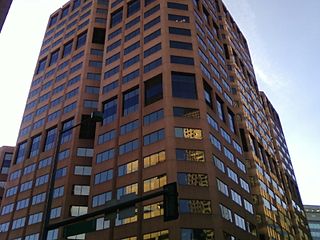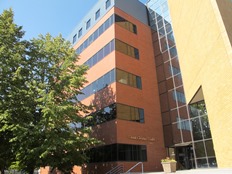
A public utility company is an organization that maintains the infrastructure for a public service. Public utilities are subject to forms of public control and regulation ranging from local community-based groups to statewide government monopolies.

The Pacific Gas and Electric Company (PG&E) is an American investor-owned utility (IOU). The company is headquartered at 300 Lakeside Drive, in Oakland, California. PG&E provides natural gas and electricity to 5.2 million households in the northern two-thirds of California, from Bakersfield and northern Santa Barbara County, almost to the Oregon and Nevada state lines.
A public utilities commission is a quasi-governmental body that provides oversight and/or regulation of public utilities in a particular area, especially in the United States and Canada.

The Louisiana Public Service Commission (LPSC) is an independent regulatory agency which manages public utilities and motor carriers in Louisiana. The Commission was created by Article IV, Section 21 of the 1921 Constitution of the State of Louisiana. It succeeded the Railroad Commission of Louisiana that was created by the 1898 Constitution. The commission has five elected members chosen in single-member districts for staggered six-year terms. Thus the commissioners have large constituencies, long terms, and close involvement with issues of intense consumer interest ; consequently membership in LPSC has been known to serve as a springboard to even higher public office, as in the cases of Huey Long, Jimmie Davis, John McKeithen, and Kathleen Babineaux Blanco — LPSC members who became governors of Louisiana.

The Oklahoma Corporation Commission is the public utilities commission of the U.S state of Oklahoma run by three statewide elected commissioners. Authorized to employ more than 400 employees, it regulates oil and gas drilling, utilities and telephone companies.

The Public Utilities Commission of the State of Colorado (PUC) provides regulatory oversight of public utilities in the State of Colorado of the United States.

The Oregon Public Utility Commission (PUC) is the chief electric, gas and telephone utility regulatory agency of the government of the U.S. state of Oregon. It sets rates and establishes rules of operation for the state's investor-owned utility companies. With respect to publicly owned utility districts and cooperatives, its authority is limited to safety regulations.

The California Energy Commission, formally the Energy Resources Conservation and Development Commission, is the primary energy policy and planning agency for California.

Community Choice Aggregation (CCA), also known as Community Choice Energy, municipal aggregation, governmental aggregation, electricity aggregation, and community aggregation, is an alternative to the investor-owned utility energy supply system in which local entities in the United States aggregate the buying power of individual customers within a defined jurisdiction in order to secure alternative energy supply contracts. The CCA chooses the power generation source on behalf of the consumers.
Sunrise Powerlink is a high-voltage power transmission line by San Diego Gas & Electric (SDG&E) in San Diego County, California and Imperial County, California. The project was approved by the United States Forest Service (USFS) in July 2010, the U.S. Bureau of Land Management (BLM) in January 2009 and the California Public Utilities Commission (CPUC) in December 2008. SDG&E states that the 117-mile (188 km) long 230/500 kilovolt power line will bring 1000 megawatts of renewable energy from the Imperial Valley to San Diego County. The cost of the project is estimated to be $1.9 billion for construction. SDG&E, which will receive a guaranteed profit of over $1.4 billion from the construction of the line, claims that the power line is necessary to support future growth of the San Diego region, and its economic benefits to the region will measure on the order of $100 million per year. However, the project has been called one of the most controversial projects ever proposed.
Dian M. Grueneich is an American scholar and former public utilities commissioner. She served as a commissioner of the California Public Utilities Commission from 2005 until 2010. She is a senior research scholar at Stanford University's Precourt Institute for Energy.

Solar power has been growing rapidly in the U.S. state of California because of high insolation, community support, declining solar costs, and a renewable portfolio standard which requires that 60% of California's electricity come from renewable resources by 2030, with 100% by 2045. Much of this is expected to come from solar power via photovoltaic facilities or concentrated solar power facilities.
Pennsylvania Public Utility Commission (PUC) is the public utility commission in Pennsylvania. It is composed of five commissioners, which are appointed by the governor with the consent of the Pennsylvania State Senate. The PUC oversees public utility and services operations in the commonwealth, in sectors including water, energy, telecommunications, and transportation.
The Public Utilities Commission of Nevada supervises and regulates the operation and maintenance of utility services in Nevada. The agency has two headquarters, one in Carson City and one in Las Vegas.

Net metering is a policy by many states in the United States designed to help the adoption of renewable energy. Net metering was pioneered in the United States as a way to allow solar and wind to provide electricity whenever available and allow use of that electricity whenever it was needed, beginning with utilities in Idaho in 1980, and in Arizona in 1981. In 1983, Minnesota passed the first state net metering law. As of March 2015, 44 states and Washington, D.C. have developed mandatory net metering rules for at least some utilities. However, although the states' rules are clear, few utilities actually compensate at full retail rates.

Solar power in Maine on rooftops, utilizing 6,300 megawatts (MW) of solar panels, can provide 60% of the electricity used in Maine according to a 2016 U.S. Department of Energy study. Maine and Vermont are tied for the second highest rooftop solar potential in the country, only behind the state of California. A 2020 estimate suggests that a typical 5.6 kilowatt (kW) residential system will pay for itself in 6-7 years and generate a profit of $45,000 over the rest of its 25-year life from the tax credits and utility savings.
Hope For The Hills (HFTH) is a non-profit grassroots organization based in Chino Hills, California, USA. It is protesting a 5-mile segment of 500kV overhead transmission lines that occupy a 150-foot right of way through a residential area in Chino Hills. The segment is part of the Tehachapi Renewable Transmission Project (TRTP). On July 11, 2013 Hope for the Hills won its long fight when the California Public Utilities Commission voted to put the lines underground.
Advanced Energy Economy (AEE) is a national trade association representing the advanced energy industry. In 2021, AEE reported over 100 member companies.

Energy in California is a major area of the economy of California. California is the state with the largest population and the largest economy in the United States. It is second in energy consumption after Texas. As of 2018, per capita consumption was the fourth-lowest in the United States partially because of the mild climate and energy efficiency programs.

The California Climate Credit is a program administered by the California Public Utilities Commission and the California Air Resources Board in which ratepayers receive a refund on their gas and electricity bills. The refund is paid in biannual installments for residential customers and monthly for small businesses. The funding for the refund comes from the utility providers who pay a carbon tax for polluting the air, and the refund is the dividend portion of the carbon fee and dividend program created by the Global Warming Solutions Act of 2006. The refund represents only a portion of the carbon tax collected, with the rest of the funds collected going towards programs to fight climate change.















